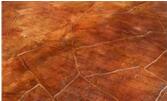What is Stained Concrete2018-08-13
Stained concrete has become a popular alternative to carpeted or hardwood floors. In 2018, more and more Architects, Designers, Builders, and Contractors tend to stain the concrete. The applications of stained concrete rang from slabs and patios, interior floors, countertops to vertical surfaces like walls or fireplaces.
Stained concrete come in two general categories: acid-based stain and water-based stain. Both types of stain can be applied to new or old and plain or integrally colored concrete. They can be used to give plain concrete a beautiful new look.
Acid-based stains (also known as reactive or chem stains) are a mixture of water, hydrochloric acid, and acid-soluble metallic salts. They react with the calcium hydroxide in the concrete.
“Because of the reactive properties with lime/portland cement, acid stains are considered a permanent, color option for interior and exterior surfaces,” says David Barreto, business development manager with Epmar Corp., in Whittier, California.
The color palette for acid-based stains is permanently altered and runs heavily to earth tones, such as tans, browns, terra cottas and soft blue-greens. However, the stain typically lasts longer than water-based stain. Moreover, the acid stains won't fade under UV , chip off or peel away.
Like acid stains, water-based stains (typically a blend of acrylic polymers and pigments) penetrate the concrete to produce permanent color, ranging from translucent to opaque depending on the product.
“The water-based stains are straight color,” says Mark Hampston, chief executive officer of Redi-Mix Colors in Taunton, Massachusetts. “You’re going to get a straight color, plus the coverage is more uniform and predictable. You can also dilute them as you’re adding different coats to make some areas darker and some lighter.”
The key difference with acid stains is that no chemical reaction occurs, so the color is more consistent. Water-based stains offer more color choices, are user-friendly and safe.
Because stains must be able to penetrate into the concrete to achieve full color saturation, they shouldn't be applied to surfaces covered by anything that can inhibit stain penetration, such as dirt, grease, glues, coatings, curing membranes and sealers.
Share to facebook
Stained concrete come in two general categories: acid-based stain and water-based stain. Both types of stain can be applied to new or old and plain or integrally colored concrete. They can be used to give plain concrete a beautiful new look.
Acid-based stains

Acid-based stains (also known as reactive or chem stains) are a mixture of water, hydrochloric acid, and acid-soluble metallic salts. They react with the calcium hydroxide in the concrete.
“Because of the reactive properties with lime/portland cement, acid stains are considered a permanent, color option for interior and exterior surfaces,” says David Barreto, business development manager with Epmar Corp., in Whittier, California.
The color palette for acid-based stains is permanently altered and runs heavily to earth tones, such as tans, browns, terra cottas and soft blue-greens. However, the stain typically lasts longer than water-based stain. Moreover, the acid stains won't fade under UV , chip off or peel away.
Water-based stains

Like acid stains, water-based stains (typically a blend of acrylic polymers and pigments) penetrate the concrete to produce permanent color, ranging from translucent to opaque depending on the product.
“The water-based stains are straight color,” says Mark Hampston, chief executive officer of Redi-Mix Colors in Taunton, Massachusetts. “You’re going to get a straight color, plus the coverage is more uniform and predictable. You can also dilute them as you’re adding different coats to make some areas darker and some lighter.”
The key difference with acid stains is that no chemical reaction occurs, so the color is more consistent. Water-based stains offer more color choices, are user-friendly and safe.
Because stains must be able to penetrate into the concrete to achieve full color saturation, they shouldn't be applied to surfaces covered by anything that can inhibit stain penetration, such as dirt, grease, glues, coatings, curing membranes and sealers.
Share to facebook
- Company Info
- Feedback
- Customer Reviews
- About Us
- Contact Us
- Blog
- Help Center
- User Center
- Forget Password
- My Orders
- Tracking Order
- My Account
- Register
Copyright © 2010-2025 DTS Diamond Tools All Rights Reserved.



